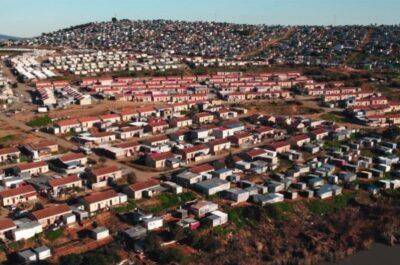#fibre
Fibre optics could be the answer to water loss from leaky pipes: 48.6 billion cubic meters of water are lost globally daily

According to the International Water Association (IWA), the main culprits for this loss are underground leaks on water mains and service pipes.
To monitor leaks in water pipeline networks, researchers at the Polytechnic University of Milan have experimented with a novel method using fibre optics — the inexpensive and commonly-used technology that allows us to have fast internet at home.
The scientists developed a distributed fibre optic sensing (DFOS) cable based on the so-called Stimulated Brillouin Scattering (SBS) technology, which enables the processing and storage of optical information.
This is a staggering amount of water lost daily, and it’s not just the drinking water itself, but for local governments it usually also means lots of lost revenue. In South Africa, we’ve seen the crazy situation where a city is being flooded by rains, but there is a shortage of drinking water. But the reason is simply due to problems with the delivery of water, even though dams may be full.
It is good to see research not only focusing on putting billionaires on Mars, but also trying to solve real-world challenges facing billions of humans on Earth right now. Water is our most precious and essential resource here on Earth, and although we may see much of it, only a very little is actual drinking water, and that water needs to reach people every day for them to survive.
It would be great if this fibre could be both used for this detection, and at the same time, also provide Internet access.
See https://thenextweb.com/news/fibre-optics-answer-to-water-loss-leaky-pipes
#Blog, #fibre, #technology, #waterleaks
Isizwe’s Fibre-to-the-shack in South Africa — uncapped 100Mbps for R5 (US$0.27) a day

“The brick structures have a fibre drop and a network termination unit. The tin structures receive their Wi-Fi through a pole-mounted outdoor, fibre-connected, Wi-Fi access point,” Briggs explained.
While the network operator initially wanted to use Wi-Fi hotspots to supply multiple homes to reduce costs, the metal shacks severely attenuated Wi-Fi signals. To work around the issue, the company connected fibre directly to homes to avoid connectivity interruptions due to signal interference.
Another aspect Isizwe had to overcome was Eskom load-shedding, which prevented residents in the township from buying Internet access. To allow residents to buy Internet access whenever needed, Isizwe installed one uninterrupted power supply (UPS) at each home.
Well that’s not a bad cost because a month would cost about R150 for uncapped 100Mbps. Very usable and affordable. I see they use a VulaCoin wallet for top-ups, so it would be interesting to know if there are any implications around that. The stated revenue earned per day per home exceeds the income from the user, so I’m imagining there is some other generation of revenue through ads being inserted? I would also think at this cost that the 100Mbps is not a guaranteed speed, but rather one that is contended with quite a few other users (like ADSL was).
See https://mybroadband.co.za/news/fibre/489603-fibre-to-the-shack-uncapped-100mbps-for-r5-a-day.html
#Blog, #fibre, #southafrica, #technology
Dans les #entrailles de la #LIVEBOX6 : #analyses, #mesures et #décorticage de son #électronique - #DeusExSilicium
https://www.youtube.com/watch?v=VryPNmlxxas
Un #épisode consacré à l' #analyse intégrale et détaillée du #hardware de la #box #internet #fibre #Orange #LIVEBOX 6.
Au sommaire :00:00 Introduction
00:43 Avant propos
01:53 Présentation rapide de la Livebox 6
02:50 Mesure de sa #consommation #électrique
03:57 Première mesure du #rayonnement #électromagnétique
04:40 Ouverture et démontage
05:52 Analyse de l' #écran à encre électronique
06:35 Découverte de son anatomie interne en détail
09:21 Seconde mesure de rayonnement électromagnétique (sans blindage)
10:08 Mesure du rayonnement #thermique (par caméra infrarouge)
10:54 Analyse détaillée des #composants de la platine radio
15:27 Analyse détaillée des composants de la #cartemère
18:47 #Schéma de fonctionnement (très) simplifié
19:03 Conclusion
Deus Ex Silicium
#SiteWeb: http://www.dexsilicium.co/
#Twitter _______________________ https://twitter.com/dexsilicium
#Instagram ____________________ https://www.instagram.com/deus.ex.silicium
#Soundcloud __________________ https://bit.ly/3e2brVf
Quand l’argent remplace le cuivre | IPNS
Un peu partout sur le territoire, des milliers de câbles de fibre optique sont déployés et l’obligation de souscrire à un abonnement « fibre » plus onéreux pour pouvoir se connecter à Internet à la maison et utiliser un téléphone fixe est déjà une réalité pour dix millions de foyers en France… Cela deviendra progressivement le cas pour tous les autres dans les prochaines années.
#politique #technocritique #productivisme #rentabilité #téléphonie #ADSL #cuivre #fibre #Progrès #IPNS
ISPs, FNOs, ONTs, WiFi, and UPSs — What terminology you should know about getting fibre for your home

Getting fibre-to-the-home (FTTH) Internet for your household will ensure you have the fastest and most reliable online connectivity on offer.
But there are various parties, several pieces of hardware, and some confusing terms involved in the process that might be a challenge for the less technically inclined.
Although the providers are South Africa specific, the terminology and components should be generic to any country, and it is useful to understand how it all fits together. Always shop around as often ISPs will have special deals if you switch to them, and remember you can choose any ISP that supports the fibre present in your area.
#technology #fibre #southafrica #ISP
#Blog, ##fibre, ##isp, ##southafrica, ##technology
South Africa’s uncapped home fibre and prepaid mobile data prices stack up reasonably well against some of the world’s bigger economies
This analysis by MyBroadband included two other African nations with growing fibre connectivity and well-established mobile networks, and seven international destinations popular with South African expats and travellers.
#technology #southafrica #fibre #mobile #benchmark
#Blog, ##fibre, ##mobile, ##southafrica, ##technology
South Africa’s uncapped home fibre and prepaid mobile data prices stack up reasonably well against some of the world’s bigger economies

This analysis by MyBroadband included two other African nations with growing fibre connectivity and well-established mobile networks, and seven international destinations popular with South African expats and travellers.
#technology #southafrica #fibre #mobile #benchmark
#Blog, ##fibre, ##mobile, ##southafrica, ##technology
FiberSense: Fiber optic cable that can sense it's about to be dug up and send a warning, or measure earthquakes or even leaky pipes
"Vibration and sound all modulate strain in fiber," Englund explained, adding that even deeply buried fibers react to vibrations and sound. FiberSense has figured out how to measure changes in a fiber and deduce what made them.
The company can therefore detect things like passing traffic with sufficient accuracy to determine the difference between a truck and a cyclist, speed of travel, and even what lane a vehicle used. Leaky pipes can also be sensed, as can the geotechnical profile of spoil beneath fibers. Backhoes and jackhammers are easy.
At sea, FiberSense can detect an anchor dragging behind a ship – which matters when those anchors are about to pass over a submarine cable (as recently happened off the Australian city of Perth, resulting in a cable cut, a subsequent outage, and the arrest of the errant ship's skipper).
This is not just a vision thing: FiberSense is already present in several Australian cities, plus London, Dublin, San Francisco, New York, and Singapore.
See Fiber optic cables used as vibration sensors challenge IoT
#technology #fibre #fibersense #IoT #cabletheft
Forget wiring cities with IoT devices – this could be how wide-scale sensing gets done
Winged Victoria
Art Dolls and Sculpture by Jennifer Schermerhorn
https://www.jenniferschermerhorn.com/gallery

via @Seedy ROM with thanks :D
New 500Mbps fibre service from Openserve launched costing only 14% more than 200Mbps
A few ISPs, including Afrihost and Cool Ideas, have already launched 500Mbps retail products based on the new Openserve service. Afrihost charges R1,297 ($86) for an uncapped 500Mbps Openserve service, while Cool Ideas charges R1,399 ($93).
Just remember that many Ethernet cables (or WifI), as well as router ports, may only be operating at a max of 100Mbps, so before considering this you may want to be sure your hardware in the house is not holding you back. Also, many servers, and international speeds, may not be sending data fast enough for you to get the benefits of this.
See New 500Mbps fibre service from Openserve launched
#technology #southafrica #fibre #openserve
Openserve has launched a new 500Mbps fibre-to-the-home service at a slightly higher price than its 200Mbps offering.
https://gadgeteer.co.za/new-500mbps-fibre-service-openserve-launched-costing-only-14-more-200mbps
Re #selfhosting.. I checked with provider Colt, because I saw their label on some utility shaft lids in neighbouring roads sidewalks. So in a quick call, they promised to call be back, which they did within the hour. Came back with prices though.. so yes, they are in the area, just across the road, some 200m away on the other side though. I can see that street corner just fine from my livingroom. Digging a trench and putting fibre in though would cost a mere 33k €€€, which I'd have to pay for (obviously) on top of the three-digit monthly fee, to repay them over a period of 2,3 or 5 years (my choice). Steep numbers front and back, whichever way I turn them, so sadly I won't be able to get symmetric fibre for cheap where I am.




